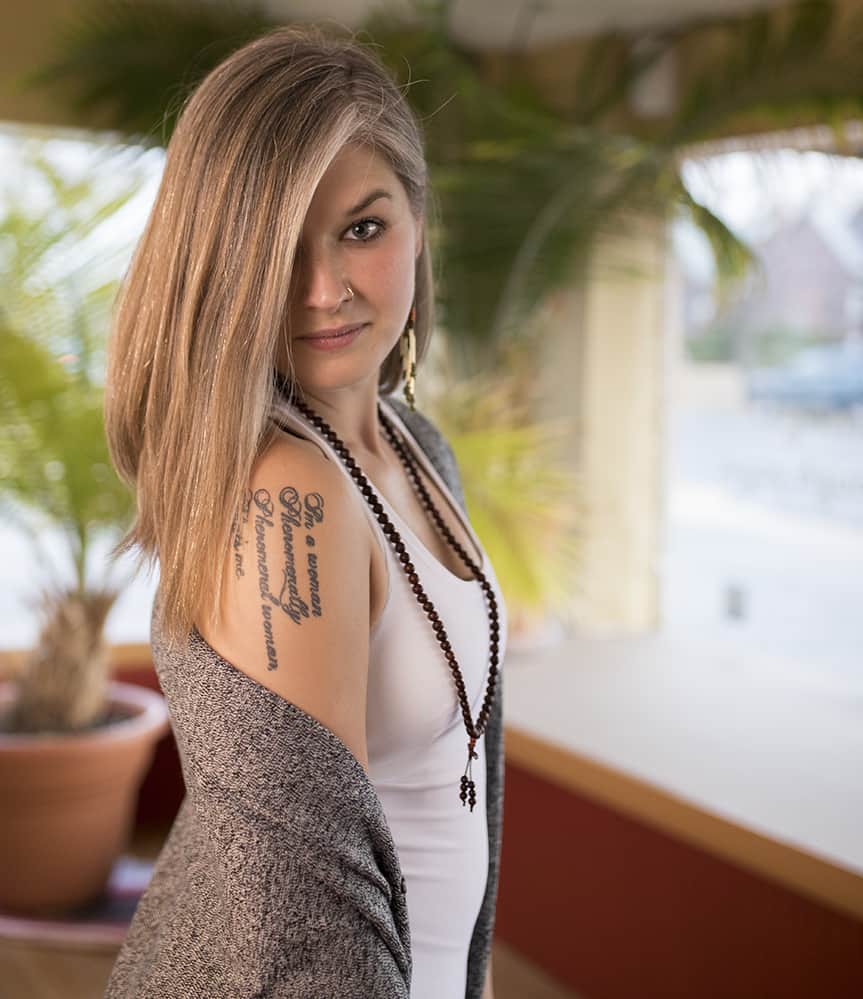
![]()
![]() I remember the day I decided to get this huge tattoo of the Goddess Durga very vividly. One of my favorite parts of my teacher training was “story time,” when we would learn about ancient texts, myths, and traditions that have informed yoga over the years. I have a Bachelor’s and a Master’s degree in English Literature, so it comes as no shock that I love a good narrative to sink my teeth into. While many feel a strong connection to the more “peaceful” goddesses Parvati, Lakshmi, or Saraswati, I knew Durga was my lady as soon as I heard her story. In yoga, we call the movement of divine feminine energy “shakti,” and when I heard Durga’s story I felt that shakti. I felt an intense pull to Durga’s energy, her modus operandi, her reason for action, her reason for being.
I remember the day I decided to get this huge tattoo of the Goddess Durga very vividly. One of my favorite parts of my teacher training was “story time,” when we would learn about ancient texts, myths, and traditions that have informed yoga over the years. I have a Bachelor’s and a Master’s degree in English Literature, so it comes as no shock that I love a good narrative to sink my teeth into. While many feel a strong connection to the more “peaceful” goddesses Parvati, Lakshmi, or Saraswati, I knew Durga was my lady as soon as I heard her story. In yoga, we call the movement of divine feminine energy “shakti,” and when I heard Durga’s story I felt that shakti. I felt an intense pull to Durga’s energy, her modus operandi, her reason for action, her reason for being.
To make Durga’s lengthy story shorter, two demon gods ask Brahma (the king of the gods) to rule over their own dimension. After subjecting them to thousands of years of trials, Brahma finally relents and grants the two demon gods their own world and the gift of invincibility. But…there is a loophole. Brahma is careful to note that no MAN may kill them, but of course there is no mention of a woman. Eons later, this loophole is realized by a wise sage and the goddess Durga is finally called upon to help out the public who have been tormented for centuries by the two demon gods. Durga takes her human form, fiercely beautiful, riding a lion, and dripping in jewels. Every man who looks upon the goddess falls madly in love with her because she is so enchanting and so striking. Durga meets with the demon gods’ guard who tells the goddess that one of his masters would happily take her as his wife. She coyly agrees to this arrangement but says that because of a girlhood promise to herself, she will not marry anyone who she has not fought with on the battlefield first. Of course, the guard thinks she’s insane. “You must not know of my masters. They will destroy you where you stand,” he says. “Even so,” Durga replies, “A promise is a promise.” Reluctantly the guard tells his masters of Durga’s demands, which they promptly scoff. They send their armies to her instead and she starts straight mowing…people…down. She possesses eight limbs, each wielding a different tool or weapon, she sends her lion in to aid in the battle, and at one point, she births Kali from her third eye to help as well. (If you don’t know about Kali, she is a force of unbridled power and energy, a fascinating goddess who asks us to embrace our wild natures). Finally, the demon gods meet Durga head on, confident in their own invincibility, but they are no match for her and she makes short work of them, restoring peace to the dimension.
Durga teaches us that no obstacle is insurmountable. We have all the tools at our disposal to overcome trials. All we need to do is search for them, embrace them, accept all parts of ourselves, be big, be bold, ask others for help when we need to, but kick ass and take names ourselves when that will do the trick instead. Durga is fiercely loyal, the mama bear to all, and the mother of all other goddesses—it’s said that all goddesses are born of her third eye. The lessons in Durga’s story are boundless. Maybe one of the reasons she resonates so much with me is because I’m a caretaker in all of my relationships; I’m a mama bear to all even though I don’t have children of my own. The qualities Durga embodies are some of those I treasure most about myself: loyalty, compassion and kindness first, but readiness to protect and defend those I love when it’s called for. Durga also tells me that I don’t have to choose only one part of myself to be. Durga is the most beautiful AND the most terrifyingly fierce at the same time. She swings a sword with one hand but holds a lotus in another, uses her bow and arrow and her mala prayer beads all at once. Durga reminds me that even in a world where women especially are constantly told we should fit into neat boxes, abide by the rules, be small, be what everyone else wants us to be, that we have a choice to do those things or not. When we are our most beautiful, our most fierce, operating in our best and highest states of being, is when we are everything at once. Durga models what I am strive to model in my life as well: to be big instead of small, to take up space, to hold it for those who are unable to, and to do it with grace, to do it with style, to do it with beauty. We have all the tools necessary to do so. We only need to look inside to find them, and when we do, embrace them and use them.

